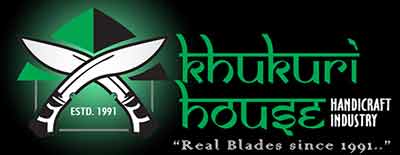10 Places Famous for Khukuri in Nepal
4th November, 2018
People, Places and Khukuri >>
Greetings folks from the land of khukuris!! Hope all is going good.
Before I start the topic I would like to hint to all that its actually KHUKURI; KHU-KU(koo)-RI (ree) and not KUKRI or even KHUKRI. Kukri is the western influenced word of khukuri when British first encountered this curve knife in the hands of Gorkhas and documented the knife in various formats. The western world was served with “KUKRI” which continues till date and sadly now dominates the original and actual word. On the other hand “KHUKRI” is heavily used in India where Khukuri saw lots of actions and activities in this country. It’s funny how this word suddenly popped out from nowhere but probably some influential guy/team heard wrong or spelled wrong and ended up misleading the people!! Who knows.. Anyways when it comes to Nepal and Nepali it is “KHUKURI” and we all Nepalese would like to keep it that way.
Top 10 Places that are famous for Khukuri in Nepal >>
Coming back to our topic, this iconic knife is made all over in Nepal be it in past or present. Its national pride, national demand plus endorsed by natural terrains and people’s lifestyle so market has always been good. Moreover it’s easier to undertake comparatively when it comes to putting things together and getting the right output in the context of Nepal and Nepalese. Amongst many places across the country Bhojpur and Dhankuta are most popular for khukuri. Below are few important and famous places that had and have close ties with the khukuri.
Most kukris are named or known after the palces they were produced and used. Khukuri found and named in different region have their features speciality and purprose. We have tried our best to sort them based on their popularity; tradionally, historically and currently. Hope you find it useful...
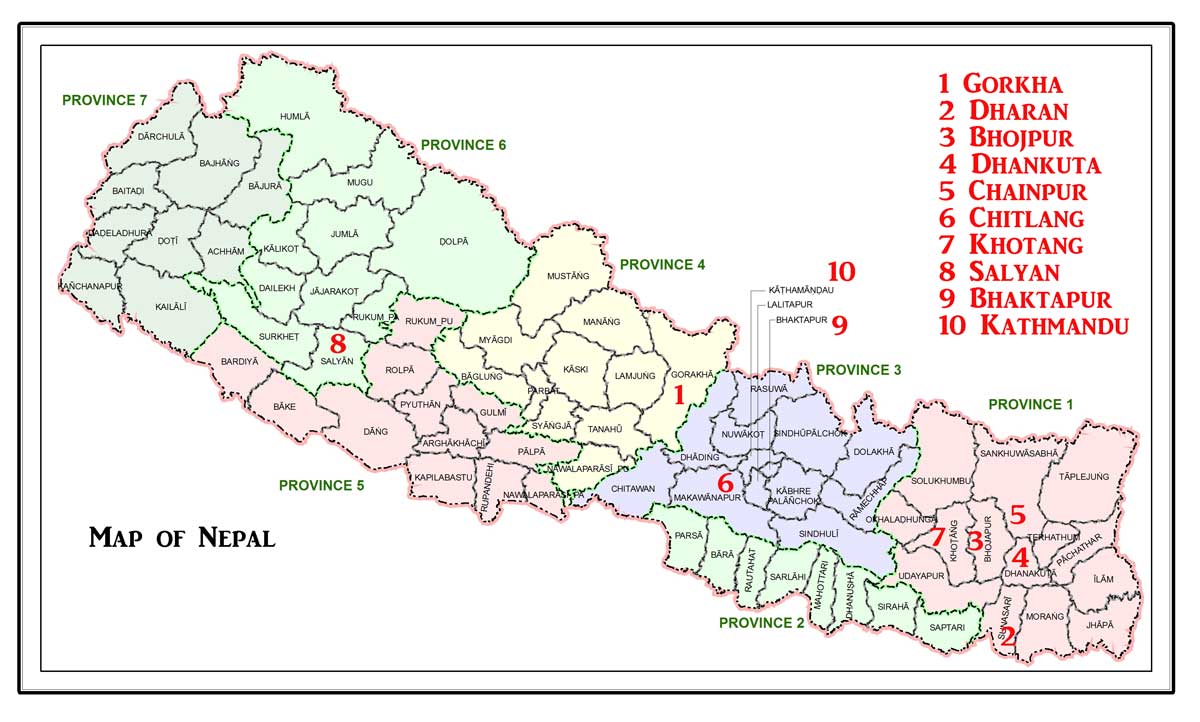
1. Gorkha
Very famous obviously due to the image and influence of the famous Gorkhali Sainik (army) and its legendary king, the great Prithivi Narayan Shah who united all kingdoms and created the modern Nepal that is today. Gorkha lies in the west central of Nepal in Gandaki state and is about 150 km away from Kathmandu (Capital). Gorkha in terms of khukuri is more famous for its users than makers. There isn’t any exclusive Gorkhali design that originated in this place that has been documented or well known but the large military style budhune khukuri from Gorkha is quite famous.
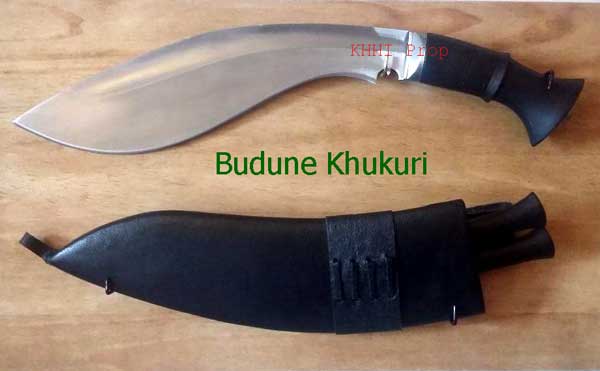
There is no specific model of Kukri originating from Gurkha but almost all the kukri are known as Gorkhali Khukuri or Gorkhe kukri. Khukuri itself is known as Gurkha Knife.
2. Dharan
Dharan is sub-metropolitan city in eastern Nepal, ( Sunsari District ) that is situated on the foothills of the Mahabharat Range in the north with its southern tip touching the edge of the Terai region at an altitude of 1148 ft.
Dharan is another well-known place for khukuri and also considered as the first centralized place to manage khukuri. After the 1947 independence of India from British, British government concentrated its army activities like recruitment of Gurkhas, operation and management of Gurkhas etc in the plain side of Nepal mainly in Dharan in mid 1950's. Heavy number of service khukuris were required so the khukuri making was centralized and mass production initiated at the industry level. Numerous makers were housed in the army camps itself to keep up with the demand and to perform repair and maintenance.
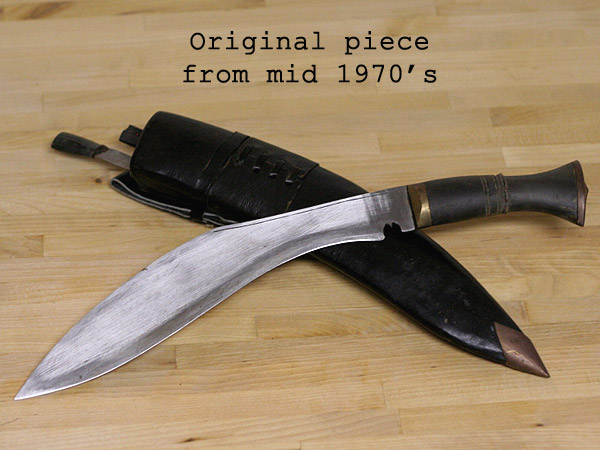 The famous khukuri also known as MK5 or GI5 by us (KHHI Nepal) was born in Dharan and many variants of this service khukuri still continue to rule till date. Here it would not be wrong to say that Dharan gave new conception and significance to the knife. Huge demand means good living and this enforced mass production and modernization to the khukuri. People came together, set up factories, contractors came forward and as a result khukuri’s growth started that brought depth and added value to the khukuri and in no time Dharan was one of the most happening places for khukuris. The huge khukuri growth was also majorly contributed by the habitants of British Gurkhas and Indian Gorkha Army as they were directly associated with the knife. Dharan still holds the largest number of factories and hence the largest producer in whole Nepal.
The famous khukuri also known as MK5 or GI5 by us (KHHI Nepal) was born in Dharan and many variants of this service khukuri still continue to rule till date. Here it would not be wrong to say that Dharan gave new conception and significance to the knife. Huge demand means good living and this enforced mass production and modernization to the khukuri. People came together, set up factories, contractors came forward and as a result khukuri’s growth started that brought depth and added value to the khukuri and in no time Dharan was one of the most happening places for khukuris. The huge khukuri growth was also majorly contributed by the habitants of British Gurkhas and Indian Gorkha Army as they were directly associated with the knife. Dharan still holds the largest number of factories and hence the largest producer in whole Nepal.
Besides the famous army model Dharan came also up with many famous models in the later years in 70’s and 80’s like the Panawal, Angkhola, chirrawal, Panjwal, Kothimora to name a few.
Khukuri originated from this region are known as Dharane Khukuri or Service khukuri.
3. Bhojpur
The most sought after name when it comes to khukuri is probably the “BhojPure” khukuri. Bhojpur is a hilly district in the eastern part of Nepal that lies in state no.1. It is famous for its traditional metal works especially its unique khukuri.
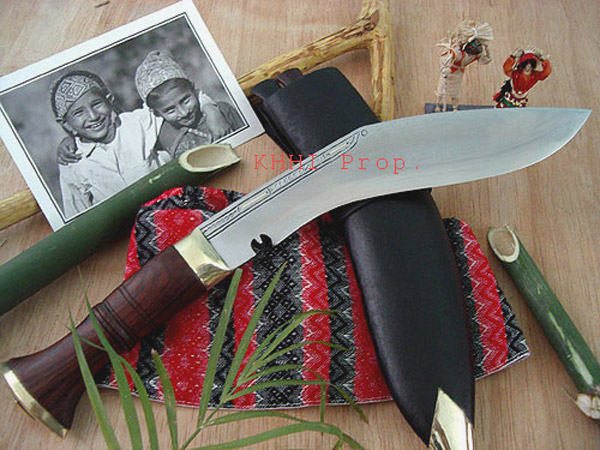 The Bhojpure khukuri which gets its name from this very village is boarder, thicker and mostly come in standard size of 10-12” long (blade). It originated few centuries ago and Bhojpures take pride and pleasure in this khukuri. It is a utility tool and lethal weapon for them. When others were happy with slim and light version Bhojpures did just the opposite by creating a fat and heavy version intended for quick and heavy blows that consumed less time. It got popular in no time and soon people were busy playing with the khukuri. BhojPure khukuri has become a household name and every Nepali keeps it in his house. People believe that a BhojPure khukuri brings fortune and keeps away satin and danger away.
The Bhojpure khukuri which gets its name from this very village is boarder, thicker and mostly come in standard size of 10-12” long (blade). It originated few centuries ago and Bhojpures take pride and pleasure in this khukuri. It is a utility tool and lethal weapon for them. When others were happy with slim and light version Bhojpures did just the opposite by creating a fat and heavy version intended for quick and heavy blows that consumed less time. It got popular in no time and soon people were busy playing with the khukuri. BhojPure khukuri has become a household name and every Nepali keeps it in his house. People believe that a BhojPure khukuri brings fortune and keeps away satin and danger away.
4. Dhankuta
Dhankuta is a small hilly town located in the eastern part of Nepal and is famous for its exclusive khukuri called the Dhankute that originated in this place many decades ago.While other places made the hardcore working khukuris Dhankuta people had other things in mind. They wanted to do both a working and showing khukuri that is extra ordinary, and something that exhibited their ability and more importantly something that represented their village.
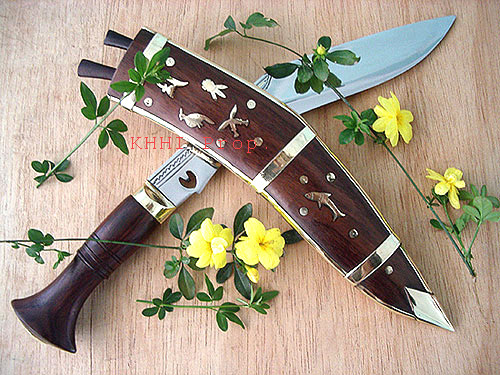 Dhankutes made a basic working khukuri but concentrated more on it’s sheath by making it out of horn or wood displaying national, religious and traditional images, icons etc unlike any other places where just simple leather was used. The fancy scabbard of the Dhankute is where the khukuri stands out from others. The use of expensive metals in the scabbard adds value to the khukuri and his owner. The glory, pride, culture, belief and persona of Nepal are captured in this unique work of art khukuri. The exact date of the origin of the khukuri is lost but we fancy it was not so long ago around late 1950’s after establishment of Dharan as the new khukuri hub.
Dhankutes made a basic working khukuri but concentrated more on it’s sheath by making it out of horn or wood displaying national, religious and traditional images, icons etc unlike any other places where just simple leather was used. The fancy scabbard of the Dhankute is where the khukuri stands out from others. The use of expensive metals in the scabbard adds value to the khukuri and his owner. The glory, pride, culture, belief and persona of Nepal are captured in this unique work of art khukuri. The exact date of the origin of the khukuri is lost but we fancy it was not so long ago around late 1950’s after establishment of Dharan as the new khukuri hub.
5. Chainpur
Chainpur village in the Eastern part of Nepal is another place that is well known for its khukuris. The khukuri is named after the village and Chainpure khukuris are originally slim, slender and light version that originated arguably in 1900’s decade.
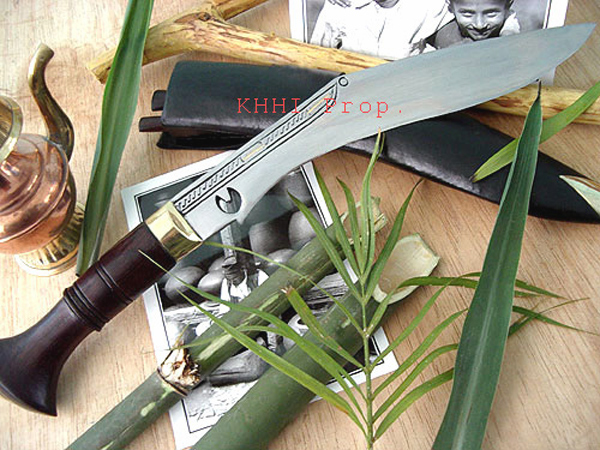 Chainpurians picked up the light and handy version as their choice of khukuri and also gave a unique touch by forging a closed notch unlike any of its counterparts. The closed notch which symbolizes the “OM” and also the foot mark of a cow, both very holy in Hinduism, became the trademark of the khukuri. Even the handle of the Chainpure was given its own touch by completely discarding the metal pommel and more flared up butt portion that has a keeper only.
Chainpurians picked up the light and handy version as their choice of khukuri and also gave a unique touch by forging a closed notch unlike any of its counterparts. The closed notch which symbolizes the “OM” and also the foot mark of a cow, both very holy in Hinduism, became the trademark of the khukuri. Even the handle of the Chainpure was given its own touch by completely discarding the metal pommel and more flared up butt portion that has a keeper only.
For the ChainPurians, their Chainpure khukuri is more a tool than a weapon hence some believe this fact led to the replacement of open notch by a closed one.
6. Chitlang
Chitlang is a small village town located 25 km south west of Kathmandu in Makwanpur District, Narayani Zone. It has its own cultural ancient Newar settlement, inscriptions dating back to Lichchavi era. Amshubarma had given the land to establish settlement for the shepherds as the saying goes.
As any villages in Nepal, Chitlang also had lots for forestation, vegetation and greenery and people needed a good knife to back them up. Chitlangese came up with their own design, probably a high influenced version of the Chainpure since it is quite similar to the Chainpure khukuri except for few features. Like the Chainpurians, Chitlangese opted for a light and slim version and even maintained the closed notch but increased the size a bit, created a hollow grind panel to control the weight and elongated the bevel to inflict deep cuts. They even gave some artistic touch to the khukuri to distinguish it from others. This cleverly done khukuri having the right technical aspect as/for a knife shows the intellectual and skilful part of the Chitlangese. Chitlange khukuri is high on demand and considered to be one of the best and useful village khukuris of all times.
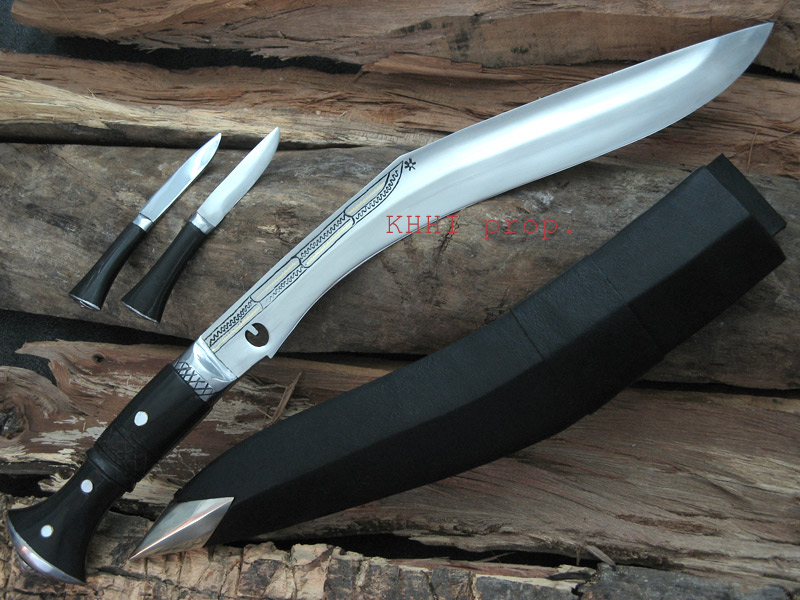 Similarly, it also believed that Chitlang housed the famous Gorkhali troops during the unification campaign from the house of Gorkha in mid 1800’s. Gorkhali Paltan (army) spear headed by the great king Prithivi when marching towards Kathmandu for invasion entered Chitlang, Makawanpur and even thought to have set base camps in Chitlang village back then. Lots of army activities including making of armours took place. Many makers remained in the place even after the successful invasion and continued the work.
Similarly, it also believed that Chitlang housed the famous Gorkhali troops during the unification campaign from the house of Gorkha in mid 1800’s. Gorkhali Paltan (army) spear headed by the great king Prithivi when marching towards Kathmandu for invasion entered Chitlang, Makawanpur and even thought to have set base camps in Chitlang village back then. Lots of army activities including making of armours took place. Many makers remained in the place even after the successful invasion and continued the work.
7. Khotang
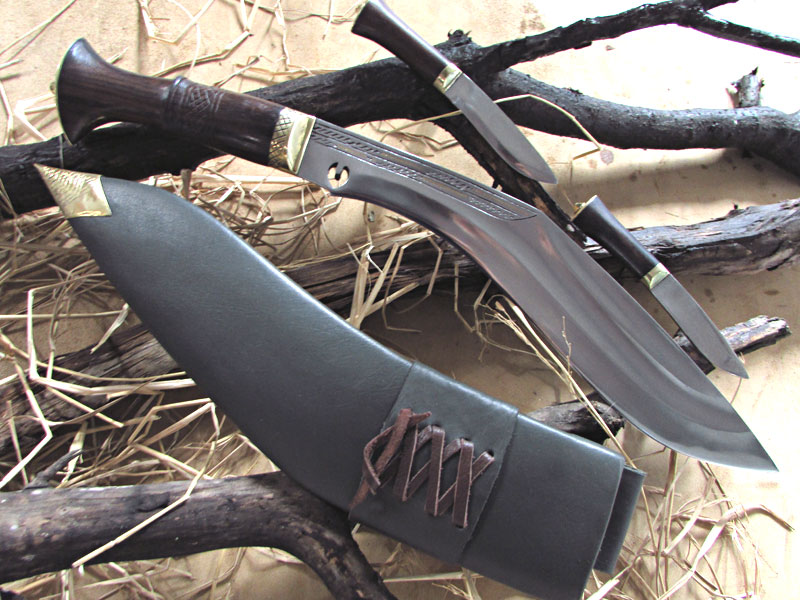 Khotang is a hilly district in East Nepal hence the area of Khotang is predominantly rural which makes external and internal accessibility very difficult. Halesi Mahadev is one of the most famous religious places in Khotang district. Along with pashmina, dhaka, wood carvings etc they also take pride in being one of the most popular metal artists in Nepal. Many types of high quality handmade khukuris are made in Khotang and supplied all over to Nepal. Kamis or Bishwakarma (BK) is the minority population of Khotang. Amongst many places Mamatim has the highest population of Kamis where most khukuris are made. It even has an iron-ore deposits and kamis used to extract/make iron from it many decades ago. Some khukuris made in Khotang are inspired from the “Bhojpure” khukuri that originated from their neighbour district, Bhojpur. However “BaasCate” is one of the famous designs that originated in Khotang made to cut bamboo, logs etc. BaasCate literally means Baas for Bamboo and Cate for cutting. This kukuri is the daily way of life for the Khotanges since most of them are farmers. Khotang khukuri is gaining good popularity in the local market.
Khotang is a hilly district in East Nepal hence the area of Khotang is predominantly rural which makes external and internal accessibility very difficult. Halesi Mahadev is one of the most famous religious places in Khotang district. Along with pashmina, dhaka, wood carvings etc they also take pride in being one of the most popular metal artists in Nepal. Many types of high quality handmade khukuris are made in Khotang and supplied all over to Nepal. Kamis or Bishwakarma (BK) is the minority population of Khotang. Amongst many places Mamatim has the highest population of Kamis where most khukuris are made. It even has an iron-ore deposits and kamis used to extract/make iron from it many decades ago. Some khukuris made in Khotang are inspired from the “Bhojpure” khukuri that originated from their neighbour district, Bhojpur. However “BaasCate” is one of the famous designs that originated in Khotang made to cut bamboo, logs etc. BaasCate literally means Baas for Bamboo and Cate for cutting. This kukuri is the daily way of life for the Khotanges since most of them are farmers. Khotang khukuri is gaining good popularity in the local market.
8. Salyan
Amongst hundreds of Khukuri makers (villages) in Nepal, Salyan, a remote district in west Nepal , is the only place that has retained the originality and authenticity of its khukuri since existence till date completely ignoring the modern demand, time and adjustment. Salyanese had their own taste of khukuris and most had a unique sickle shaped khukuri with no shoulder (jooro) at all. Primary made as a battle knife it was also largely used for domestic purpose. In the event of unification from the kingdom of Gorkha in 1760 and later, Gorkhali Sainik had to face the gruesome edge of the Salyani khukuris of the Salyan rajya but later had to submit to Gorkha’s supremacy. In the later years many Gorkhas are seen carrying this unique knife against the British Raj.
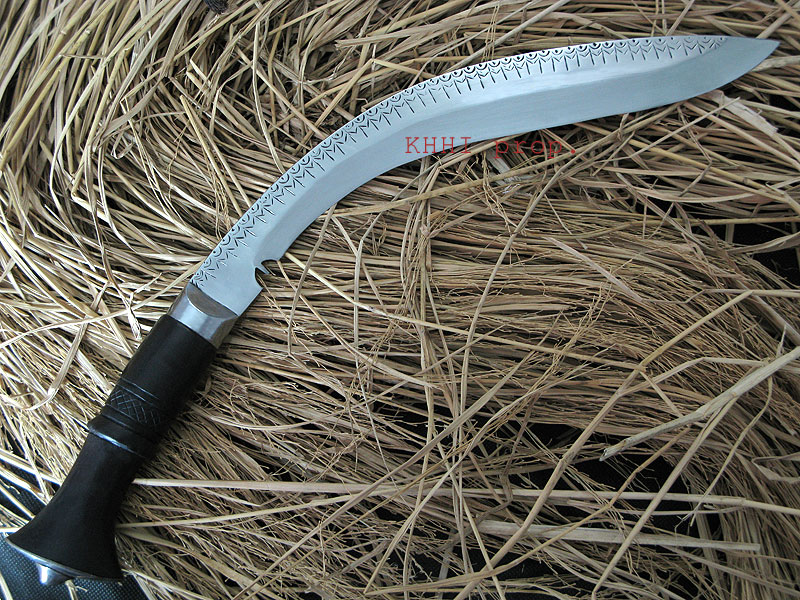 Amongst the many khukuris made in Nepal this classic version that dates back to many centuries continues to please the modern era. Not well known in the contemporary market but it has always been a prized possession to an in-depth khukuri collector and history community.
Amongst the many khukuris made in Nepal this classic version that dates back to many centuries continues to please the modern era. Not well known in the contemporary market but it has always been a prized possession to an in-depth khukuri collector and history community.
9. Bhaktapur
An ancient Newari city in the east corner of the Kathmandu Valley, about 13 km from the capital city, Kathmandu, Bhaktapur has recently gain some popularities in khukuri in the local market. With the flourish of khukuri market many people started to set up workshops in Bhaktapur particular due to low living cost than in Kathmandu, easy accessibility to raw materials and better scopes and facilities compared to other places.
Bhaktapur neither has any patent khukuri nor has close association with the making and development of the khukuri but in recent years it has been haven for numerous local makers and thus production sharply rocketed. Mainly local customers are well aware of khukuris from Bhaktapur and often seen buying directly from the makers. Bhaktapures mostly concentrate their khukuris on typical lines and many are seen with raw black finishing having good weight in them. The local folks are fond of traditional versions and that’s what Bhaktapures do as they highly depend on them. Bhaktapures have also won many official supply tenders of Nepal Police, Armed Police Force etc.
10. Kathmandu
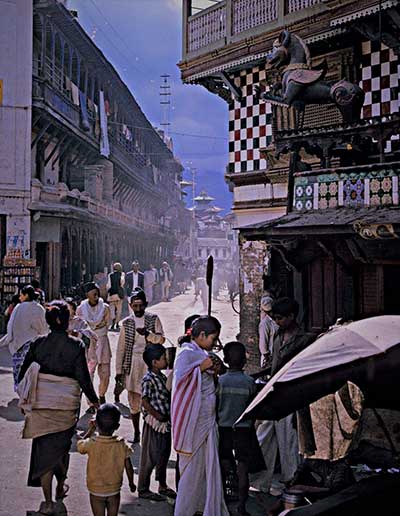 Kathmandu in recent years especially after 2000 has gained immense popularity for buying and making khukuris. Historically speaking Kathmandu was never associated with or known for khukuri. It never had its own exclusive khukuri; nothing has been documented or heard of or even talked about. However Kathmandu being the capital city of Nepal offers huge scope, prospect and facilities and thus in no time it saw large number of people picking up the business and doing aggressive marketing. The modernization of khukuri, its professional approach and organized production heavily contributed to introducing Kathmandu as one of the best places to buy/make khukuris. Unique and innovative, modern and extravagant, special and stylish etc khukuris in various sizes are the deliverance of Kathmanduties. The highest number of sellers and contractors and even individuals makers are plentiful in Kathmandu. Thamel, the toursit street for Nepal is a commerical hub for mainly fancy, decorative, and giftable cheap kukris.
Kathmandu in recent years especially after 2000 has gained immense popularity for buying and making khukuris. Historically speaking Kathmandu was never associated with or known for khukuri. It never had its own exclusive khukuri; nothing has been documented or heard of or even talked about. However Kathmandu being the capital city of Nepal offers huge scope, prospect and facilities and thus in no time it saw large number of people picking up the business and doing aggressive marketing. The modernization of khukuri, its professional approach and organized production heavily contributed to introducing Kathmandu as one of the best places to buy/make khukuris. Unique and innovative, modern and extravagant, special and stylish etc khukuris in various sizes are the deliverance of Kathmanduties. The highest number of sellers and contractors and even individuals makers are plentiful in Kathmandu. Thamel, the toursit street for Nepal is a commerical hub for mainly fancy, decorative, and giftable cheap kukris.
Thank you for reading this article. I do hope you enjoyed it and gained some knowledge. The data has been collected for general information purpose only. Please don’t forget to give your inputs to me at saroj@thekhukurihouse.com JAI KHUKURI!!
